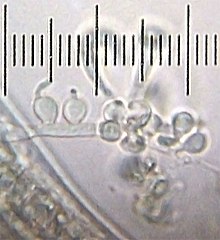Nematophagous mushrooms
Nematophagous fungi are a special group of carnivorous fungi that specialize in nematodes as prey. About 160 species are known.
Demarcation and capture organs
A distinction is made between predatory fungi and endo- parasitic nematophages. Predatory and endoparasitic fungi share some characteristics that make a taxonomic differentiation difficult and sometimes even impossible (in the case of the genus Nematoctonus, for example, in which both ways of life are found).
In the literature, only those species that have special trapping organs on external hyphae are unanimously understood as predatory . These fishing organs are in about 80% of all cases sticky traps (z. B. in Zoophagus insidans ), occasionally at the adhesive threads and rotifers can catch and 20% catch rings such. B. in the species Zoophagus tentaclum . Here, hyphae form small loops in which z. B. can catch roundworms. The snare traps can be contractile, the snare tightens through contact stimuli and prevents the prey from escaping. They can be distinguished even more finely:
- Glue traps
- Simple sticky catch hyphae
- Sticky tentacles
- Sticky safety nets
- Sticky fishing knots
- Catch rings
- Contractile catch rings
- Non-contractile catch rings
It is rare for species to have two different types of trap, e.g. B. Dactylaria candida or Arthrobotrys botryospora .
The method of catching with catch rings is evolutionarily quite old, as the discovery of a 100 million year old nematophagous fungus in a piece of amber - not closely related to today's species - made clear.
Predators (predators)
Predatory mushrooms are mushrooms that actively catch roundworms with special catching devices, either sticky traps to which the prey sticks or ring traps in which the nematodes get caught while crawling through. Once caught, the fungus grows into the nematode and gradually decomposes it from within using enzymes ; the released nutrients are absorbed.
Due to the frequent occurrence in nitrogen-poor soils, it is likely that, as with most carnivorous plants, the prey is caught less for the production of metabolic energy and more to balance the nitrogen balance.
The Schopftintling ( Coprinus comatus ) - a mushroom - can catch and digest nematodes. It forms small spherical structures with thorny outgrowths. Through this it excretes a toxin that makes nematodes immobile. The nematodes are finally colonized by the mycelium of the intestine and digested within a few days.
Endoparasitic nematophages
Endoparasitic nematophages do not catch nematodes, but grow in the nematode from the spore stage and gradually digest it from the inside. The nematodes are infected by ingesting the spores or by spores that attach to the outside of the nematodes and later grow into the worm. Another mode of infection can be found in the genus Haptoglossa: this obligate parasite has spores, the plasma content of which is shot into the future host on contact with a nematode. After the spores germinate , they form a hyphae in the nematode, which later breaks through the cuticle and forms conidia as new spore carriers. Permanent spores can also form in the decomposed nematodes .
Systematics
The majority of all predatory fungi in this sense belong to the order of the Moniliales in the class of the Deuteromycetes , but a few can also be found in the family of the Zoopagaceae ( Zygomycetes ) and the mushrooms (Basidiomycetes).
Use in crop protection
Due to their effectiveness, nematophagous fungi should also be used in plant protection against phytopathogenic nematodes, but the applications are still being tested (e.g. Paecilomyces ).
proof
- Asmus Dowe: Predatory mushrooms and other fungal nematode enemies , A. Ziemsen Verlag, Wittenberg, 1987, ISBN 3740300426
Individual evidence
- ↑ Alexander R. Schmidt, Heinrich Dörfelt & Vincent Perrichot: Carnivorous fungi from Cretaceous amber . In: Science, Volume 318, No. 5857, p. 1743, December 14, 2007 doi : 10.1126 / science.1149947 .
- ^ Luo, Hong; Mo, Minghe; Huang, Xiaowei; Li, Xuan; Zhang, Keqin: Coprinus comatus: A basidiomycete fungus forms novel spiny structures and infects nematode , in: Mycologia, 2004, Vol. 96, Ss. 1218-1224, PDF Online .
further reading
- Barron, GL (1977): The Nematode-Destroying Fungi. Topics in Mycobiology No. 1; Canadian Biological Publications; Guelph, Ont./Ca
- Dürschner, Ulrike (1983): Fungal endoparasites on mobile nematode stages. Messages from the Federal Biological Research Center for Agriculture and Forestry; Issue 217
Web links
- Full website on nematophage mushrooms
- PDF at www.bba.de (4.67 MB)
- Video: Nematophagous mushrooms . Institute for Scientific Film (IWF) 1995, made available by the Technical Information Library (TIB), doi : 10.3203 / IWF / C-1851 .
